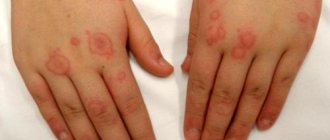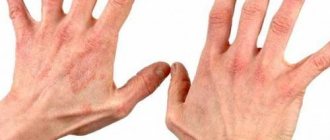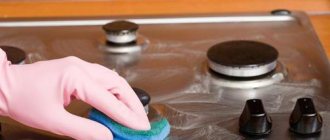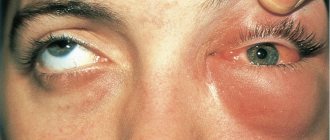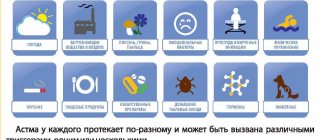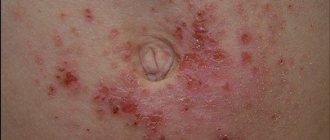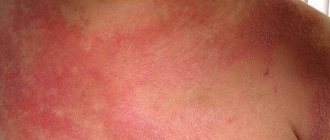Sooner or later, each of us experiences allergic reactions to medications, food, household chemicals or other allergens. According to statistics, every 3 people suffer from allergic reactions every year. In this article, we propose to understand allergens and what a rash from one or another type of allergic reaction looks like.
Eczema is a group of itchy, inflammatory skin conditions. Another name for eczema is atopic dermatitis. For some, eczema may begin in infancy or childhood and continue into adulthood, while for others, eczema goes away with age. Eczema begins as a collection of blisters that develop into a thick, scaly, intensely itchy rash. There are many different types of eczema.
- Atopic dermatitis is a form of eczema associated with the same immune response that underlies allergies and asthma (atopic disease). Atopic dermatitis often becomes chronic.
- Contact dermatitis occurs when allergens or irritants cause inflammation of the skin. Allergens can be plants, pets and certain foods. Irritants can include chemicals in cleaning products, cosmetics, paints and solvents. Contact with fragrances or certain fabrics can trigger dermatitis.
- Dyshidrotic dermatitis causes small, fluid-filled blisters to form on the arms and legs. The blisters are very itchy.
- Neurodermatitis (chronic lichen simplex) is an intensely itchy rash that often occurs on the forearms, thighs, or ankles. Severe discomfort from the rash causes scratching, which increases the itching.
- Nummular dermatitis is a scaly patch or circle-shaped sore that can occur after an injury, insect bite, or burn.
- Seborrheic dermatitis (seborrheic eczema) causes yellow, scaly patches, usually on the scalp.
Atopic dermatitis
Eczema is an inflammatory skin disease. There are many different types of eczema, but the most common type is atopic dermatitis. Heredity plays a very big role in determining who suffers from atopic dermatitis. People diagnosed with atopic dermatitis are much more likely to develop other atopic disorders, including allergies and asthma.
Atopic dermatitis is a common skin condition in children, causing patchy areas of redness, usually on the cheeks and chin.
Juvenile palmoplantar dermatosis

Most often occurs in children aged 3 to 14 years. The affected skin has a scaly, glazed and shiny appearance. Children with eczema, asthma and hay fever are particularly susceptible to juvenile plantar dermatosis. Juvenile plantar dermatosis is caused by a combination of certain conditions, such as sweat, dryness, and rubbing of the feet. Sometimes the cause of this type of dermatosis is synthetic shoes, shoe material made of nylon or vinyl, as they prevent the feet from drying out.
Allergic contact dermatitis
Allergic contact dermatitis is a skin reaction that occurs after contact with an offending substance. Common irritants include scented foods, jewelry containing nickel, rubber, bleach and hand sanitizers.
Skin affected by allergic contact dermatitis may be red, itchy, swollen, and warm to the touch. Bubbles filled with clear liquid may form. These signs and symptoms are the result of an allergic response. Another name for allergic contact dermatitis is allergic contact eczema.
In the photo on the left is a hand after a henna tattoo; henna itself is safe for human health, but the girl turned out to be allergic to one of the components of the paint.
Contact dermatitis
Nickel contact dermatitis causes a characteristic red, itchy rash that resembles eczema. In this photo, it appears around the belly button after the victim's skin comes into contact with a metal clasp on jeans or a metal belt buckle. The skin rash may appear on the knees and elbows at the same time. Red, itchy lesions can be soothed by topical corticosteroids.
Skin allergies and blisters
An allergic disease is never asymptomatic. Often, an allergic reaction manifests itself on a person’s skin with a number of unpleasant signs that cause him quite severe discomfort, sometimes accompanied by pain. A watery blister is an elevation above the surface of the skin, which is formed by the upper layer of the epidermis.
If a person develops an allergic rash in the form of blisters with watery content, then he needs to take some measures during this period. Particular attention should be paid to the diet, namely the food that a person eats every day. The list of prohibited foods includes table salt - it is what prevents the removal of fluid from the human body.
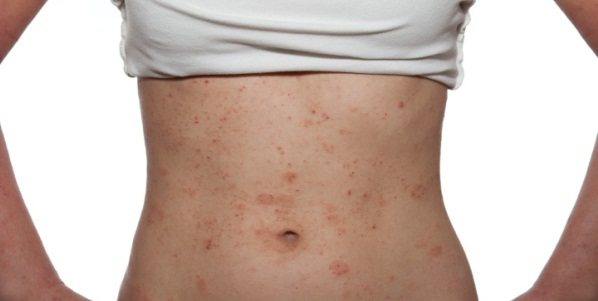
Watery blisters may contain pus or fluid inside. Most often, such a skin defect can be found on a person’s hands. Also, bubbles can affect almost all parts of the body or be localized only in one specific place. If the integrity of the epidermis and the membrane of the skin is damaged, the skin on the affected area may dry out, resulting in the formation of a crust on the surface. This process often leaves pigment spots that can persist for a long time.
Watery blisters on the skin are completely different in external characteristics - shape, color, quantity, contents of the rash, location. All external manifestations depend directly on the individual characteristics of the human body.
Pediatric contact dermatitis
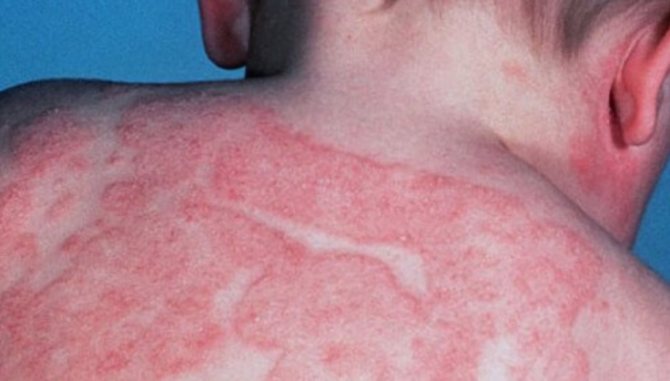
Children with this disease suffer from dermatitis (inflammation of the skin) due to allergies that are sensitive to certain substances, most often affecting children under five years of age. Typical symptoms are a red, itchy rash and scaly, dry skin. The best way to treat and avoid this type of contact dermatitis is to avoid any contact with nickel. Exposure to nickel for a few hours a month is enough to cause the dermatitis to reappear. People with nickel contact dermatitis should avoid jeans with metal snaps, jewelry containing nickel, and ear or body piercings.
Treatment methods and preventive measures
Treatment of hand allergies is carried out by completely eliminating contact with the allergen. If irritation is caused by direct contact with cosmetics or household chemicals, then it is important to replace the products with hypoallergenic ones. If you have food irritation, you should follow a special diet.
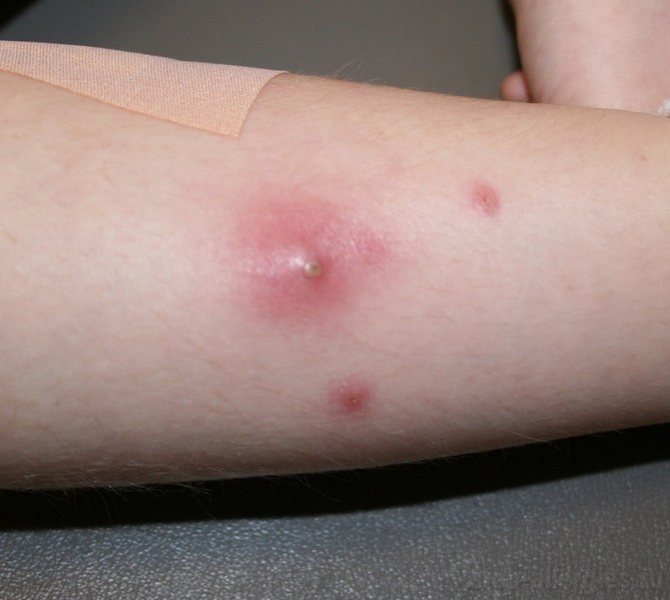
Therapy can only be carried out after consultation with a doctor. It is forbidden to prescribe medications yourself. In this case, the allergy may only get worse.
They help resolve blisters, as well as eliminate itching, redness, and peeling.
To reduce the permeability of the walls of blood vessels and strengthen them, calcium-containing drugs are prescribed. In this case, the liquid that fills the bubble does not form. Vitamins A, C, and E have the same effect.
It is also necessary to use agents that relieve inflammation: silver nitrates, Ichthyol ointment, tannin.
To relieve itching, treatment is carried out with Menthol, Anestezin, Diphenhydramine, carbolic, citric and acetic acids.
It is important to remain calm during therapy. Bubbles can form under the influence of stress or nervous tension.
After drug therapy, you need to follow skin care rules. It is worth replacing cosmetics with hypoallergenic ones that help soften and moisturize. It is also necessary to avoid synthetic substances in the composition.
It is important to consult a doctor promptly and follow preventive measures to protect the skin.
The first thing to do in order to cure an allergy is to limit further contact with the irritant.
- When handling household chemicals, be sure to use protective vinyl gloves. But don't wear them for long periods of time, as sweating under gloves aggravates hand allergies.
- Completely avoid touching allergens that have been identified using patch tests.
- When washing your hands, use baby soap.
- To prevent cold allergies on your hands from taking you by surprise, take measures to protect your skin. Wear gloves and use moisturizer to prevent skin chapping and irritation.
In the event that an allergy occurs on the hands, treatment should be carried out using ointments and antihistamines.
Taking antihistamines will eliminate itching, including between the fingers. These drugs include tablets: Zodak, Claritin, Erius, etc. and ointments: Fenistil gel, Psilobalm, Fladex.

Antihistamines for hand allergies
In some cases, as prescribed by a doctor, a corticosteroid (hormonal) ointment for hand allergies is used, which has an anti-inflammatory effect: Hydrocortisone, Advantan, Akriderm, Triderm, etc.
Hormonal ointments for allergies
To prevent dryness and flaking of the skin on the hands, emollient creams are used.
They create a protective layer in the form of a film and also help retain moisture in the skin. Allergy between the fingers thanks to the use of these products causes a person much less discomfort. These drugs include: Locobase, Emolium, Topicrem, etc.
Cream to protect the skin from external irritants
Sorbents are also used to remove allergens from the body: activated carbon, Polysorb, Carbopect, etc.
Before treatment, diagnostic procedures are carried out to reliably find out which stimulus caused the reaction. The patient is prescribed tests:
- blood for allergen and immunoglobulin E,
- skin samples (scrapings),
- examination of urine and feces for the possibility of infection with parasites.
Complete exclusion of the allergen from life is the main component of a successful prognosis for the patient.
Therapy
The use of ointments, creams and gels for skin allergies
To get rid of allergy blisters, your doctor may recommend several treatment options. If there are suspicions of diseases that contribute to the development of allergic reactions, additional studies and instrumental diagnostics are carried out.
When a disease is detected, the doctor prescribes treatment for the underlying pathology. It is recommended to carry out general strengthening measures and increase immunity. The patient is recommended to undergo sanitation of the oral cavity, examination and treatment of the ENT organs and digestive system.
After the procedure, you need to treat the problem area of the skin with antiseptics and local anti-inflammatory agents (Chlorhexidine, Diclovit).
To get rid of itching, Anestezin, Diphenhydramine, and external preparations with a cooling effect that relieve swelling are prescribed (Fenistil).
To relieve allergy symptoms accompanied by the appearance of blisters with fluid, drug therapy is prescribed. Depending on the severity and extent of the rash, several groups of medications are used.
- Antihistamines (Claritin, Tavegil, Peritol). They completely suppress or reduce the effect of the allergen or histamine. The patient experiences a decrease in swelling of tissues and mucous membranes.
- Hormonal drugs of the glucocorticoid group (Kenalog, Triamcinolone, Dexamethasone). They stabilize cell membranes, which stops the spread of the inflammatory process and relieves severe allergic manifestations.
- To reduce the permeability of vessel walls and prevent exudative filling of blisters, calcium-containing preparations (Calcium chloride, Calcium gluconate) are used.
- Enterosorbents (activated carbon, Polyphepan, Enterosgel).
- Vitamins A, E, C. They complement the treatment, help reduce the permeability of vascular walls, and have a general strengthening effect on the body.
Folk recipes
Skin allergies with blisters can be treated using alternative medicine recipes. Their action is aimed at mitigating and removing local manifestations of the pathological process.
- Therapeutic baths with the addition of herbal infusions significantly reduce itching. The recipes involve using various types of raw materials - string, chamomile, nettle, oak bark. You can brew the plants separately or in a herbal mixture by mixing the components in equal parts. The procedure is repeated daily, the minimum course is a week. It is not difficult to prepare an infusion: 30 g of plant material is steamed in 3 liters of boiling water for 2 hours and poured into a pre-filled bath. The water temperature for swimming should be 37-38 °C, duration - 10-15 minutes.
- Herbal infusions are used as a basis for compresses. They are prepared in a similar way, only in a smaller ratio - 3 g of dried herbs per 100 ml of water. The compress is left on the skin for 20-25 minutes.
- To strengthen the immune system, it is recommended to use decoctions of herbs, for example, chamomile, nettle, rose hips. A cup of boiling water will require 3-5 g of medicinal plants.
- Products prepared on the basis of baby cream have a local effect. An additional component is added to it - sea buckthorn oil in a 2:1 ratio. The ointment is applied to the affected area 2-3 times a day.
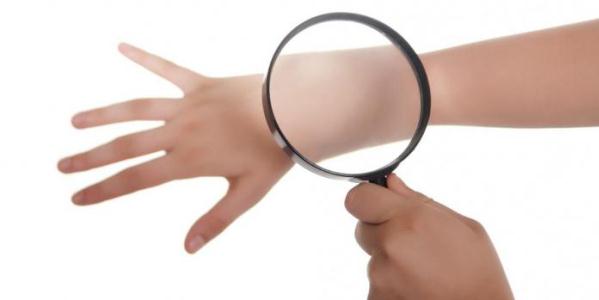
Allergies in the form of spots on the skin: causes and methods of getting rid of them
If an allergy with blisters occurs, a specialist will tell you how to treat the pathology. In this case, it is recommended to consult a dermatologist or allergist. The doctor will help determine the cause of the pathology and prescribe appropriate therapy.
To diagnose the disease, the following studies are prescribed:
- blood test for the presence of immunoglobulin E;
- epidermal scrapings;
- feces and urine tests to determine the presence or absence of parasites in the body.

After identifying the allergen, it is necessary to completely eliminate contact with it. Only this guarantees the success of the therapy.
There are several ways to treat the pathology. The main thing is to establish the cause of the allergy and eliminate it. This also applies to diseases that provoke the appearance of blisters on the skin.
If an allergy occurs in the form of blisters on the body, the doctor prescribes drug therapy. The following drugs are usually prescribed:
- Antihistamines. These include Loratadine, Suprastin, Claritin, Fenistil and other similar drugs. The drugs rid the body of the allergen and eliminate symptoms;
- Glucocorticoids. These are hormone-based products. Drugs are prescribed only for acute pathology and if other methods of therapy have proven ineffective. The period of treatment with hormonal medications should not exceed three days. The dosage of drugs and the duration of therapy are determined by the doctor, depending on the nature of the disease and the individual characteristics of the patient;
- Products prepared on the basis of calcium. A specialist prescribes such drugs to strengthen the walls of blood vessels and prevent relapse of the disease;
- Enterosorbents. Rids the body of waste and toxins. Doctors usually prescribe Polysorb, activated carbon and other medications;
- Multivitamin complexes. The product increases the body's defenses and generally has a positive effect on the condition of all organs and systems.
Cercariasis

Parasites are carried by infected snails, birds and other animals. A rash develops in 1 in 3 people who come into contact with the organism. The erythematous (reddened) rash may cause itching, burning, or stinging. Small blisters may appear within minutes to several days after exposure to parasites. Swimmer's itch may last a little over one week, but will eventually go away.
Swimmer's itch usually does not require medical attention. Treatment for swimmer's itch may include the use of creams to reduce pain and itching. Cortisosteroid cream is one option. A bath containing Epsom salts, baking soda or colloidal oatmeal will be soothing. Cool compresses applied to the skin can help reduce the symptoms of inflamed skin.
Causes
Patients with allergies always have a hereditary predisposition to its occurrence. Among relatives there will definitely be allergy sufferers, and their allergies can manifest themselves in different ways: skin, food, allergic rhinitis, bronchial asthma - the form does not matter.
To develop the clinical picture, exposure to a sensitizing substance—an allergen—is necessary. They can be dust, pollen, chemicals in detergents, clothing, hazardous industries, some food products, medicines, etc., as well as substances formed in the body itself under the influence of cold or sunlight, metabolic products of parasites.
